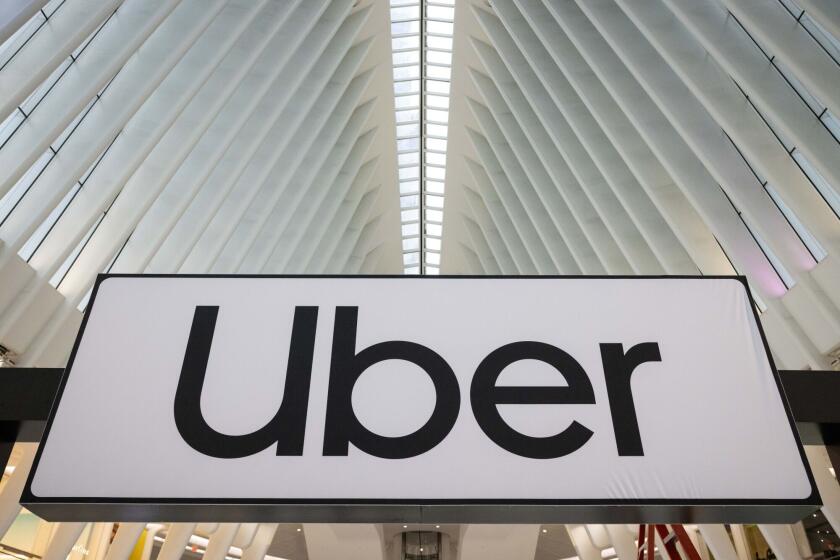Poles Apart on Beautification
- Share via
You don’t need welcome signs to locate the boundary between the cities of Los Angeles and West Hollywood on Santa Monica Boulevard. All you need to do is look up.
Eastward from La Brea Avenue, the Los Angeles view is cluttered with utility poles and wires for electricity, telephone and cable television service. Westward from La Brea, the West Hollywood sky is suddenly, and blissfully, clear.
The reason is that Southern California Edison Co. has put utility lines beneath West Hollywood’s portion of the busy boulevard. The city of Los Angeles, which runs its own municipal utility, does not participate in the expensive but popular statewide effort for beautification.
The wooden poles and black wires are “really visual pollution,” contends West Hollywood city engineer Sharon Perstein. Their removal, along with the addition of such street improvements as lamps and trees, helped revive the boulevard’s retail shops and cafes she added.
“It looks much, much better, like a more cosmopolitan city,” agreed Sal Marino, owner of La Bottega Marino, an Italian deli on Santa Monica Boulevard near West Hollywood City Hall. Despite inconvenience during the digging and construction, the only unhappy people now are yard sale sponsors who stapled fliers on the poles, he joked.
In staggered sections, the poles began to be removed on Santa Monica Boulevard in West Hollywood six years ago. Work on the final section, westward from Palm Avenue into Beverly Hills, is expected to start in January.
Meanwhile, Edison company officials report similar projects are underway or recently completed throughout Southern California, including stretches of Carson Avenue in Long Beach, Foothill Boulevard in La Crescenta, Cesar Chavez Boulevard in East Los Angeles, Beach Boulevard in La Habra and Fourth Street in Santa Ana. Projects also are planned on Sepulveda Boulevard in El Segundo, Olympic Boulevard in Santa Monica and Golden Avenue in Long Beach.
All rely on a 1968 state Public Utilities Commission rule that a small portion of electric rates be set aside for such projects. Cities are rationed work according to their number of customers and city councils usually choose where the money should be spent, with emphasis on busy or scenic streets. (Municipal utilities such as Los Angeles’ Department of Water and Power are not under PUC rules.)
While the effort began for aesthetics, demand is rising because of safety concerns. “It’s mushrooming because of the fires,” PUC analyst William Gaffney said, referring to the October 1991 fires that ravaged the Oakland and Berkeley hills. Those blazes were made worse by fallen high-voltage lines. Reconstruction there includes underground cabling, the cost of which is being shared by the local utility, city governments and property owners.
Below-ground utility cables are protected from winds, birds and motorists crashing into poles. But even encased in hard plastic conduits and sometimes in concrete shells, flooding and earthquakes can still cause problems.
New suburban subdivisions routinely have underground utilities, whether in the city of Los Angeles or in adjacent territory serviced by Edison. The vast majority of older neighborhoods still have poles. Ripping up roadways and sidewalks to insert the new wires is complicated work, and the cost averages $1 million per mile and much more in densely populated areas, Edison reports.
Those costs are why the DWP more than 20 years ago stopped replacing poles with underground lines in existing neighborhoods. “With the choices one has to make on capital improvements, the undergrounding for beautification is a lower priority than it was in the ‘60s and early ‘70s,” said DWP spokesman Ed Freudenburg.
That is an embarrassment to Los Angeles, stressed Jeffrey Daniels, director of the architecture and interior design program at UCLA Extension. “This should have been taken care of years ago as a way to beautify the city,” he said. “You travel to any other major metropolis in the world and it is fairly unusual to see it covered with power poles.”
Yet, given the expense, removal of overhead wires may not be the most efficient way to improve a street’s look, said Rick Willson, chairman of the Department of Urban and Regional Planning at Cal Poly Pomona.
In fact, some urban designers are in revolt against the sterile look of suburbia and actually consider utility poles to be interesting urban artifacts. Such an attitude would puzzle Robaire Boisvert, co-owner of Trash With Class antiques store in West Hollywood. “All those wires were ugly,” he recalled. “That’s the only way I can describe it.”
More to Read
Sign up for Essential California
The most important California stories and recommendations in your inbox every morning.
You may occasionally receive promotional content from the Los Angeles Times.














